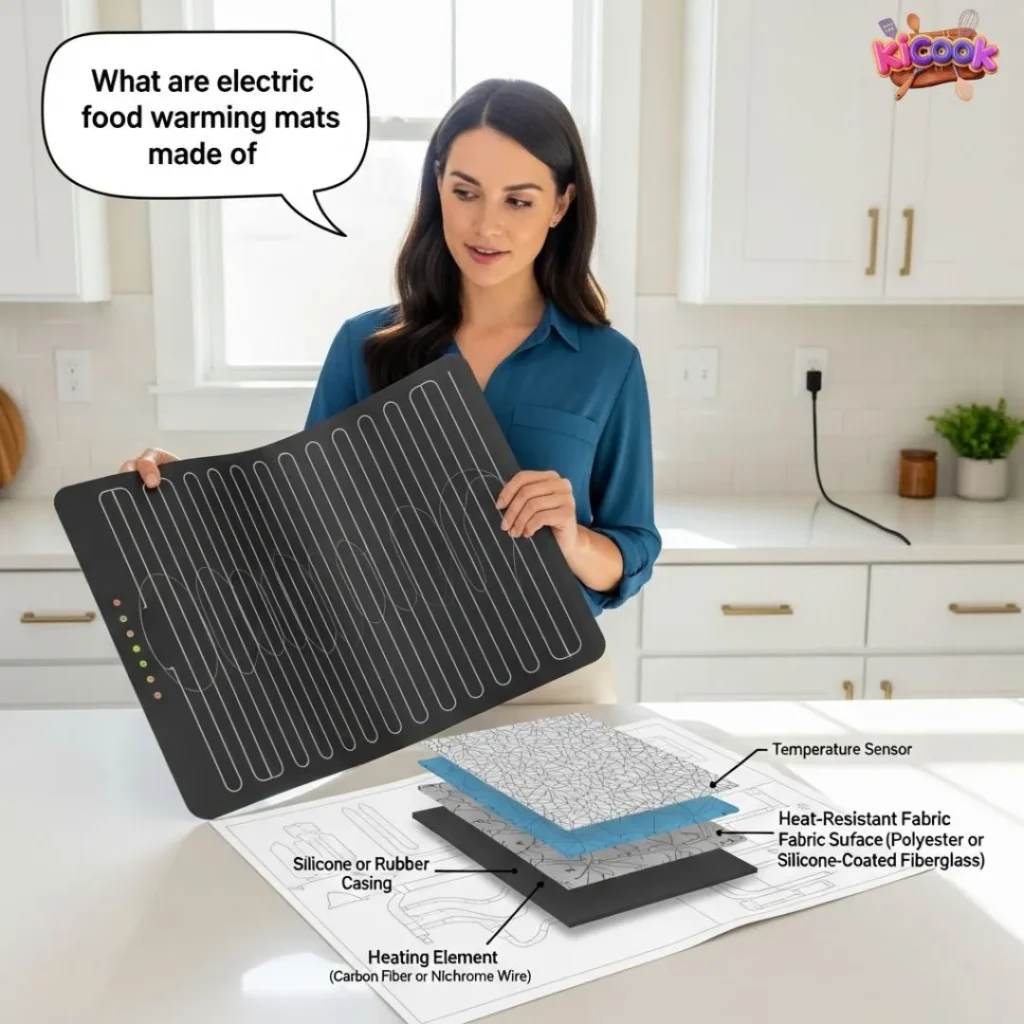Electric food warming mats are primarily made from a safe, flexible food-grade silicone outer layer that houses an internal heating element, often a thin, insulated Nichrome wire, all built upon a sturdy and heat-resistant base.
I was hosting a holiday dinner a few years back, and it was a complete disaster. Not the food the turkey was juicy, the potatoes were fluffy but by the time I finished carving the bird and got everyone seated, the side dishes were already lukewarm. I remember feeling so frustrated. I’d put in all that effort, only for the meal to be let down by cold food. It was that exact moment I went on a mission to find a better way, which is how I discovered electric food warming trays and, more specifically, the flexible warming mats.
I became a bit obsessed. I wanted to know everything about them: how they work, if they’re safe, and crucially, what materials are electric food warming mats made of? I knew if I understood the materials, I could trust their safety and performance. After spending a good amount of time researching, testing, and even talking to folks in the know, I feel like I’ve got a solid handle on it. So, let’s get into the details together. I want to share what I’ve learned to help you make a smart choice and finally say goodbye to cold casseroles and congealed gravy.
The Heart of the Warmth: Breaking Down the Materials
When you look at a simple, flat warming mat, it’s easy to think it’s just a piece of plastic that gets hot. But there’s a clever and thoughtful combination of materials inside that makes it so effective and safe. We can break it down into three main parts: the top surface, the internal heating system, and the base.
1. The Top Surface: Your Food’s Direct Contact
This is the part of the mat that your plates, platters, and pots sit on. It needs to be safe for food contact, easy to clean, and a good conductor of heat.
- Food-Grade Silicone: This is, without a doubt, the most common and reliable material for the top layer. I personally prefer mats that use high-quality silicone, and here’s why:
- Heat Resistance: Silicone can handle a wide range of temperatures, from very cold to the typical warming temperatures of 150°F to 200°F (65°C to 93°C), without degrading or melting.
- Non-Toxic and Safe: High-quality, food-grade silicone is free from harmful chemicals like BPA, PVC, and lead. This gives me total peace of mind when I’m warming food directly on it or placing a plate on its surface.
- Flexibility: Its inherent flexibility makes these mats easy to roll up for storage. I can tuck mine right into a kitchen drawer.
- Waterproof and Easy Cleanup: Spills and splatters are a given in the kitchen. A silicone surface is completely waterproof and wipes clean with a damp cloth in seconds.

- Thermoplastic Elastomers (TPE): You might also come across some mats made with TPE. It’s another type of flexible, BPA-free polymer that shares many properties with silicone. It’s generally a cost-effective option, though in my experience, premium mats tend to stick with silicone for its proven long-term durability and heat tolerance.

“Good food is a foundation for genuine happiness. A simple tool that keeps it warm extends that joy.” – Sarah Johnson, Home Cook & Blogger
2. The Internal Heating Element: The Engine Inside

Tucked safely between the layers is what actually generates the heat. This isn’t a simple light bulb or a hot plate; it’s a sophisticated, low-profile system.
- Nichrome Wire: The heating element itself is typically a very thin, coiled wire made from an alloy of Nickel and Chromium, known as Nichrome. This is the same material used in your trusty toaster. Why? Because it’s an excellent and predictable conductor of electricity. When current passes through it, it heats up evenly and consistently without getting red hot, providing a gentle, spreading warmth perfect for food.
- Insulation and Sheathing: The thin Nichrome wire is always insulated, often with a durable material like fiberglass or a high-temperature silicone coating. This is a critical safety feature. It prevents any electrical short circuits and ensures the heat is distributed evenly across the entire surface of the mat, eliminating dangerous hot spots.
- Even Heat Distribution: The way the wire is laid out in a consistent pattern across the mat is key. A good mat will have a well-designed layout that ensures the heat spreads uniformly, so one corner of your dish isn’t scalding hot while the other is cold.
3. The Base and Structural Layers

What holds it all together? The base is just as important for safety and function.
- Heat-Resistant Base Layer: The bottom of the mat is usually made from a more rigid, heat-resistant material. This is often a thicker type of rubber or a composite material. Its job is twofold: to protect your countertop or table from excessive heat and to provide a non-slip, stable grip so the mat stays put.
- Internal Construction: All these layers the top silicone, the insulated heating element, and the base are fused together through a manufacturing process called lamination. This creates a single, sealed unit that is thin, effective, and safe.
Why Do These Specific Materials Matter to You?
Knowing the “what” is one thing, but let’s connect it to the “why.” The choice of these specific materials directly solves some very real kitchen problems we all face.
- Pain Point: “I’m worried about burning my expensive dining table.”
- Solution: The combination of the low-temperature heating element and the insulated base layer is specifically chosen to provide a safe level of heat upwards while protecting surfaces below. You can confidently place it on a wooden table without leaving a mark.
- Pain Point: “Is it safe to use around my family? What about electrical safety?”
- Solution: The use of insulated Nichrome wire and fully sealed, waterproof construction means there’s no risk of electric shock from spills. The materials are chosen to operate at temperatures that keep food warm without posing a burn or fire hazard under normal use.
- Pain Point: “I need something easy to store. My kitchen is already cluttered.”
- Solution: The flexibility of silicone and TPE is the direct answer. Because these materials aren’t rigid, you can simply roll up the mat and store it almost anywhere. It takes up a fraction of the space a bulky appliance would.
“The right materials in a kitchen tool don’t just perform a function; they provide peace of mind, letting you focus on your guests.” – David Chen, Product Designer
Beyond the Mat: Understanding Features and Benefits
Now that we know what they’re made of, let’s look at how this material choice translates into the features you’ll see on the box.
- Waterproof & Easy to Clean: This is a direct result of that seamless silicone or TPE top layer. You can wipe off grease, gravy, or sugar spills with ease. This makes it perfect for buffets, outdoor barbecues, or even a kid’s birthday party.
- Flexible & Portable: The inherent properties of the polymers used make this possible. I love taking my mat to potlucks. It’s much easier to carry than a heavy, solid warming tray.
- Energy Efficient: Compared to a traditional oven, which uses 2000-5000 watts to reheat or keep food warm, a typical electric food warming mat uses only 15 to 40 watts. That’s a massive difference on your energy bill! The materials (like the efficient Nichrome wire) are key to this low power consumption.
- Adjustable Temperature Control: Many mats come with a simple dial or a few preset buttons. This controller regulates the power going to the Nichrome wire, allowing you to set the perfect warmth level for different types of food, from delicate sauces to hearty stews.
Frequently Asked Questions for Electric Food Warming Mats
Are electric warming mats truly safe to leave on for hours?
Yes, when used according to the manufacturer’s instructions, they are designed for extended use. The materials, like the insulated Nichrome wire and heat-resistant base, are selected specifically for stable, long-term operation. However, it’s always a good practice to unplug any electrical appliance when you’re not nearby or after the event is over.
Can I place a metal pot or a cast-iron skillet directly on the mat?
You can, but be cautious. Metal is an excellent conductor of heat and can create a concentrated hot spot on the mat’s surface. It’s better to use a trivet or a heat diffuser between the mat and heavy metal cookware to promote even heat distribution and protect the mat’s surface.
What’s the difference between a warming mat and a hot plate?
This is a great question. A hot plate is designed to cook food—it gets much hotter (often over 400°F / 200°C) and has a concentrated heat source. A warming mat is designed only to keep already hot food warm. It uses lower, gentler, and more evenly distributed heat, which is why the material construction is so different.
My mat has a slight smell when I first use it. Is that normal?
A faint, harmless odor is common during the very first use. This is usually just the off-gassing of the manufacturing process from the polymers and can happen with any new electrical appliance. It should disappear quickly and never return. Simply run the mat on its highest setting for 10-15 minutes in a well-ventilated area without any food on it.
How do I clean my electric food warming mat?
Always unplug it and let it cool completely. Then, just wipe the surface with a soft, damp cloth. For stuck-on food, a little mild soap is fine. Never submerge the mat in water, and never put it in a dishwasher. The electrical components are sealed inside, but the power cord and connection point are not waterproof.
Making the Right Choice for Your Home
When you’re looking to buy one, keep the material information in mind. Look for phrases like “food-grade silicone,” “BPA-free,” and “waterproof construction.” These are your indicators that the manufacturer has prioritized safety and quality. Check the wattage to get an idea of its energy use and ensure it has the kind of temperature control you want.
“Investing in a tool made with care and the right materials is an investment in the quality of your daily life.” – Maria Rodriguez, Consumer Advocate
Conclusion
My quest to answer “what materials are electric food warming mats made of?” started with a simple desire to keep my mashed potatoes hot. It ended with a real appreciation for the smart, safe, and thoughtful engineering that goes into these handy kitchen helpers. The combination of food-grade silicone, insulated Nichrome wire, and a protective base isn’t an accident; it’s a precise recipe for solving a common problem effectively and safely.
Understanding these materials has given me the confidence to use my mat frequently, knowing it’s protecting my counters, my food, and my family. It’s turned stressful, rushed meals into relaxed, enjoyable gatherings. I hope this deep dive helps you feel the same confidence and brings the joy of always-warm food to your table.

